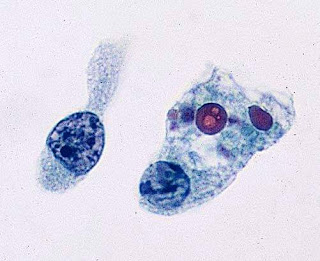Formalin pigment
Formalin pigment:
A formalin-fixed paraffin section of kidney showing the typical deposition of acid formaldehyde hematin (formalin pigment) associated with red blood cells. The pigment is brown to black in color and is birefringent under polarized light. In this case the specimen remained in fixative for an extended period before processing.
Formalin pigment is a brown, granular, doubly refractile deposit seen both intracellularly and extracellularly in tissues which have been fixed with a simple formalin solution, such as formal-saline. It is also known as acid formaldehyde hematin, as it is formed from hemoglobin by the action of formaldehyde at acid pH. The hematin being referred to in this context is the derivative of hemoglobin and not the oxidation product of hematoxylin, called hematein.
This material is found in tissues that have been fixed in simple formalin fixatives, such as 10% formalin and 10% formal saline. As these solutions age, formic acid developes from the formaldehyde content and lowers the pH. This in turn causes crystals of formalin pigment, or acid formaldehyde hematin, to be deposited throughout the tissues. This is more common in tissues that are bloody, but it will occur in nearly all tissues eventually, especially when they are stored in those solutions for extended periods. It should be noted that formalin pigment can form quite quickly, overnight or in a few days, if the formalin is distinctly acidic and the tissue is bloody.
Formalin pigment may be easily stopped from forming by using 10% neutral buffered formalin (NBF) as the fixative. Since its formation is dependent on an acidic pH, buffering to pH7 effectively stops it. However, it may still form if tissues are stored in NBF for very extended periods without changing the solution. The NBF should be changed every six months at a minimum. Doing so effectively stops formalin pigment from forming.
If NBF is not available and either 10% formalin or 10% formal saline are being used, they should be stored over marble chips or crushed oyster shells to neutralise any formic acid as it is produced. This is not as effective as using NBF because the fixative is removed from the carbonate when it is used, and there is no longer a means to neutralise the acid.
In small amounts the pigment does not interfere with slide examination, but large amounts can be distracting. It may be removed from sections prior to staining quite easily by immersing in ethanolic picric acid, a method given below. It may also be removed with alkalis such as 1% sodium hydroxide in absolute ethanol, but these very frequently cause sections to detach from slides and should be avoided.
A formalin-fixed paraffin section of kidney showing the typical deposition of acid formaldehyde hematin (formalin pigment) associated with red blood cells. The pigment is brown to black in color and is birefringent under polarized light. In this case the specimen remained in fixative for an extended period before processing.
Formalin pigment is a brown, granular, doubly refractile deposit seen both intracellularly and extracellularly in tissues which have been fixed with a simple formalin solution, such as formal-saline. It is also known as acid formaldehyde hematin, as it is formed from hemoglobin by the action of formaldehyde at acid pH. The hematin being referred to in this context is the derivative of hemoglobin and not the oxidation product of hematoxylin, called hematein.
This material is found in tissues that have been fixed in simple formalin fixatives, such as 10% formalin and 10% formal saline. As these solutions age, formic acid developes from the formaldehyde content and lowers the pH. This in turn causes crystals of formalin pigment, or acid formaldehyde hematin, to be deposited throughout the tissues. This is more common in tissues that are bloody, but it will occur in nearly all tissues eventually, especially when they are stored in those solutions for extended periods. It should be noted that formalin pigment can form quite quickly, overnight or in a few days, if the formalin is distinctly acidic and the tissue is bloody.
Formalin pigment may be easily stopped from forming by using 10% neutral buffered formalin (NBF) as the fixative. Since its formation is dependent on an acidic pH, buffering to pH7 effectively stops it. However, it may still form if tissues are stored in NBF for very extended periods without changing the solution. The NBF should be changed every six months at a minimum. Doing so effectively stops formalin pigment from forming.
If NBF is not available and either 10% formalin or 10% formal saline are being used, they should be stored over marble chips or crushed oyster shells to neutralise any formic acid as it is produced. This is not as effective as using NBF because the fixative is removed from the carbonate when it is used, and there is no longer a means to neutralise the acid.
In small amounts the pigment does not interfere with slide examination, but large amounts can be distracting. It may be removed from sections prior to staining quite easily by immersing in ethanolic picric acid, a method given below. It may also be removed with alkalis such as 1% sodium hydroxide in absolute ethanol, but these very frequently cause sections to detach from slides and should be avoided.



Comments
Post a Comment
Thank you for posting your comment.Your question will be answered soon.